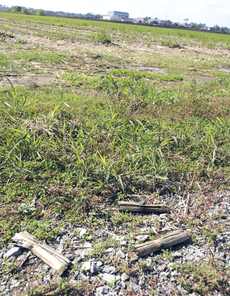The strong smell of bagasse and the sweet smell of sugar may not remind people of clean energy, but a professor of biological sciences at Nicholls. Raj Boopathy, is working to change that. With the help of a $1.9 million grant from the U.S. Department of Energy, Boopathy’s goal is to find an inexpensive and clean alternative fuel using sugarcane. Ethanol, the same alcohol found in alcoholic beverages, can also be used as an alternative fuel source. Ethanol is predominately produced from corn kernels; Boopathy and his research want to change that. “Corn is a main food crop. They are diverting the corn to make ethanol so that’s why the corn price is going up,” he said. “So what we are suggesting is to not use the food crop, use the residue, use the waste product to make ethanol.”
When sugarcane is harvested, only the stalks of the sugarcane are needed and the leaves are burned as waste in the fields. “What we are trying to do is use that sugarcane leaf as a resource and we can make ethanol from the leaf,” Boopathy said.
Boopathy believes planting corn for the sole purpose of making ethanol isn’t a green concept because gasoline is used to harvest the corn and 100 percent of that corn is going to make ethanol. Boopathy’s research uses waste products, so it’s greener for the environment.
Once the leaves from the sugarcane are collected, a complex chemical called lignin is removed from them, leaving cellulose and hemicellulose. These two compounds are then broken down with enzymes to make glucose and xylose, the starting sugars for fermentation to make ethanol.
The two sugars have to be broken down separately. A bacteria breaks down the glucose and a fungus breaks down the xylose. Because of the two-step process, Boopathy is losing ethanol. If he could genetically engineer an organism that would make fermentation a one-step process, then more ethanol could potentially be produced. Boopathy is currently trying to produce a recombinant organism, an organism that is created by joining together DNA segments. By joining the DNA segments of the bacteria and fungus used in the fermentation processes, both glucose and xylose can be fermented at the same time.
In addition to the sugarcane leaves, Boopathy is also making ethanol from bagasse, another sugarcane waste product. “If we can prove that we can make it from these two sources, it can be made from any agriculture crop; it is not specific to sugarcane,” Boopathy said.
The gasoline used in standard vehicles contains 10 percent ethanol and 90 percent gasoline. Flexible-fuel vehicle models, also known as FFVs, run primarily on alternative fuel. This fuel can consist of up to 85 percent ethanol and 15 percent gasoline. These vehicles are also called E85, because they can run on up to 85 percent ethanol. Boopathy said his research is geared towards these Flexible-fuel models. According to the U.S. Department of Energy, there were 8.35 million FFVs being used in the United States in 2009.
Cost is the biggest problem the research team is facing. Boopathy said the only reason corn is currently a viable alternative fuel source is that the government is giving corn growers subsidy. Boopathy said the government subsidizes 30-40 percent of corn ethanol because of corn growing lobbyists.
The ethanol from sugarcane currently costs approximately $13 a gallon. If the government would subsidize the sugarcane as an ethanol source, Boopathy said the fuel will be competitive, and his goal is to bring costs down to approximately $2 to $3 a gallon.
Boopathy said his research could potentially enhance the sugarcane industry in the future. Leaf litter and bagasse could become a value-added product sold to an energy company, instead of waste burned in the fields.
According to the American Sugar Cane League (AMSCL), sugarcane is being grown on 450,000 acres of land in 23 Louisiana parishes. The AMSCL website estimates that production should exceed 14 million tons of cane with an economic impact of $1.7 billion to the cane farmers and sugar factories in the state each year.
The head of the Nicholls Biology Department, John Doucet, believes Boopathy’s research will not only benefit the sugarcane farmers in the state, but Nicholls State University as well. “Essentially he is tackling a world problem with local resources,” Doucet said. “For a university of our size to be tackling a global problem like this is tremendous. It puts us on the forefront of alternative fuel research.”
In addition to sugarcane, Boopathy is also working with a new variety of cane the USDA has released called energy cane. Four varieties of energy cane have been released and Boopathy tested three of them in his laboratory. He experimented with these varieties to determine which variety yields the most energy. This cane could potentially be the super cane of the future. If the ethanol from energy cane becomes a viable alternative for ethanol fuel, Louisiana’s sugarcane fields could grown energy cane 12 months a year and produce both sugar and alternative energy.
Energy cane can grow on land that is not prime for agriculture. It can also withstand drought, flood and cold temperatures. “Sugarcane is harvested here between September to December because we get a freeze in January. It can’t take the freeze,” Boopathy said. “Energy cane can take the freeze, it will be a 12 month crop.”
The energy cane works better for producing energy than sugarcane, but contains less sugar. Boopathy said energy cane contains five percent sugar, while sugarcane contains 13 percent, but since energy cane contains more leafy material it can potentially yield more energy.
Instead of ethanol, energy cane can also be used for coal generation, a newer energy generation method. At its simplest form, plant residue like bagasse can be burned in the form of pellets in a furnace, which generates heat that goes into a steam boiler, which can run a generator and produce electricity. Coal generation may provide even more opportunities for farmers growing cane in Southeast Louisiana. However, even with energy cane, the country’s energy problems are not completely solved.
“We cannot meet 100 percent of the petroleum based energy currently. We could replace and potentially meet 50-60 percent if the government pushes alternative energy,” Boopathy said. These figures include other alternative energies, such as natural gas.
“We can’t wait,” Boopathy added, “we are running out of petroleum based products. It’s going to be gradual, but in my opinion, we are running out of time.








